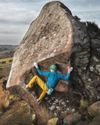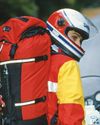CALCULATED RISK
Rock and Ice
|June/July 2020
HOW UNDERSTANDING DANGER COULD KEEP YOU OUT OF HARM’S WAY

I remember getting to the final move, which happens to be the crux. My friend Ben and my bouldering pad both looked disappointingly far away, like a Lego man and a postage stamp. Ben had stepped back. Spotting was pointless. It all felt quite unnerving. From my stance I looked up, then down … then up again. I pondered the drop and anticipated the move.
I stepped up, executed the move, and though I was scared, it felt easy. I topped out. This was the first real risk in climbing that I’d taken.
If we were to assume no risk at all, we’d never get out of bed. We choose to take risk to get things done. In climbing, especially so. The important thing is weighing the level of risk against the danger involved: a proper analysis takes time and experience. Climbers need to be their own judges to know what is and what isn’t acceptable risk and potential for harm. Some people are willing to take greater risk and will happily forge into the red zone, whereas others are cautious and stay in green. Most people have dabbled inside the orange zones.
Whether pros or novices, all climbers need to continuously monitor both factors to the best of their ability to stay safe.
THE TERMS OF THE DEAL
Let’s begin by defining some terms.
このストーリーは、Rock and Ice の June/July 2020 版からのものです。
Magzter GOLD を購読すると、厳選された何千ものプレミアム記事や、10,000 以上の雑誌や新聞にアクセスできます。
すでに購読者ですか? サインイン
Rock and Ice からのその他のストーリー
Rock and Ice
Call of Duty
Vikki Weldon: Hard lines and the front line
4 mins
June/July 2020
Rock and Ice
THE BADGE
WE DEFINE OURSELVES AS CLIMBERS, BUT IS THAT GOOD ENOUGH?
6 mins
June/July 2020
Rock and Ice
THE ACHIEVER
MARICELA ROSALES HAD EVERYTHING AGAINST HER. SHE BECAME A CLIMBER ANYWAY.
13 mins
June/July 2020
Rock and Ice
Chris Sharma
FIRST ASCENTIONIST, FORMER WORLD CHAMPION, OWNS GYMS IN SPAIN AND USA. INTERVIEWED IN QUARANTINE IN BARCELONA WITH HIS WIFE, 3-YEAR-OLD DAUGHTER AND 1-YEAR-OLD SON.
5 mins
June/July 2020
Rock and Ice
PROJECT WAIT
A LIFELONG CLIMBER CONSIDERS THROWING IN THE TOWEL
10 mins
June/July 2020
Rock and Ice
Older, Wiser, Stronger!
YES, THEY CAN GO TOGETHER. HOW TO TRAIN STRENGTH AS YOU COME ALONG DOWN THE ROAD.
7 mins
June/July 2020
Rock and Ice
CALCULATED RISK
HOW UNDERSTANDING DANGER COULD KEEP YOU OUT OF HARM’S WAY
5 mins
June/July 2020

Rock and Ice
Accessories To Climb
Field tested
6 mins
February/March 2020

Rock and Ice
To The Grit
About 10 winters ago I touched down in Manchester in a hard, driving English rain. The city was hidden from view. I was groggy after a red-eye from Dallas, an over-brewed black tea barking on my dry tongue.
17 mins
December/January 2020

Rock and Ice
The Wild Ones
North Conway is a typical New Hampshire town tucked among rolling hardwood hills and set at the foot of imposing granite slabs, but 30 years ago it was the stage on which a small band of climbers led the way in boldness and vision.
24 mins
December/January 2020
Translate
Change font size

